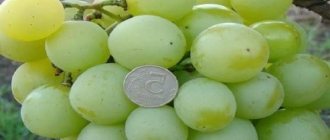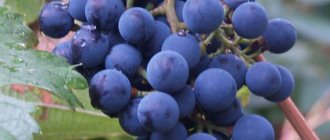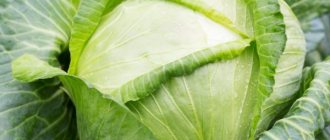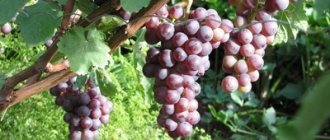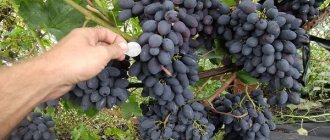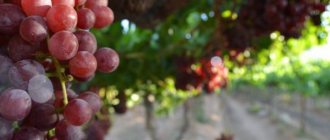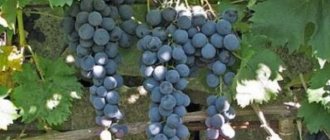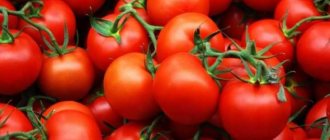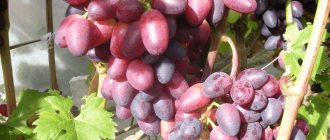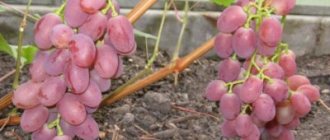Loading... Early grape varieties are especially popular because they can be grown in any climate. And if they are still sweet and stable, this only speaks in favor of the right choice. Timur grapes have these and not only positive qualities, the description of the variety is known to many. Its large clusters of sweet berries can be immediately recognized by their elongated and fleshy grapes and rich nutmeg aroma. Timur's parents were the grapes Delight and Frumoasa Albe. They gave it not only excellent taste, but also early ripeness and resistance to frost and disease.
Advantages and disadvantages
Pros:
- Early fruit ripening.
- Berries with a delicate muscat taste and thin skin.
- High resistance to diseases.
- Frost resistance.
- Stable and abundant yield.
Minuses:
- The bushes are low-growing and require a rootstock for taller varieties.
- When grown in wet and heavy soils, the berries may lose their flavor and become grassy.
- The sweet pulp and thin skin attracts a large number of wasps.
Reproduction of the variety: how and when to do it
This variety can be propagated by cuttings, seeds, layering and seedlings.
Cuttings are carried out in the autumn.
Advice! They need to be dug in for the winter, then by mid-April they will acquire a powerful root system and will have good winter hardiness.
The seed propagation process is considered the longest and most energy-consuming. But in grape nurseries it is used quite often, since bushes grown from seed have strong immunity to many diseases.
Description
The Timur grape variety was bred by Russian breeders at the All-Russian Research Institute of Viticulture and Winemaking named after. ME AND. Potapenko.
At the end of the 20th century, breeding specialists crossed the grape varieties “Delight” and “Frumoasa Albe”. The result was a table variety of light grapes, which was called “Timur”.
Parents of “Timur” – “Delight” and “Frumoasa Albe”
From the parent varieties, “Timur” inherited high disease resistance and the ability to produce crops in a very short time.
Timur grape variety: care rules
Timur grape variety: care rules
In order for grapes to actively bear fruit and develop well, they require enormous care, even more labor-intensive than other grape varieties.
Here are the basic rules for caring for this crop:
- The soil next to the boles should be mulched with sawdust or moss.
- The plant must be regularly watered, especially in the period before flowering and during the period of fruit formation. Otherwise, a lack of moisture can lead to a decrease in the yield of ripe fruits and a decrease in the size of the berries. During a dry summer, the crop begins to be watered even more often than usual.
- The bushes must be pruned twice a year, leaving approximately 12 eyes on each shoot. The bunches are also normalized: usually, the load is on average 27 buds per bush. Experienced gardeners advise not to leave more than 20 buds on a bush, so that the clusters are larger.
- At least twice a year, the grapes must be fertilized with either organic or mineral fertilizers; the main thing is not to overdo it with nitrogen.
- Regardless of the age and size of the grape bush, this crop simply needs to be covered for the winter. The most effective method is bending the vine to the ground, when the trunk is first tied, and then laid on spruce branches (sawdust is also suitable) and sprinkled with earth or snow.
- Every year, follow a number of preventive measures and treat the bushes with special preparations before the vines flower and immediately after flowering.
Be sure to follow these rules and tips so that this variety bears fruit well and develops, because it is very demanding of care.
Main characteristics
Reference! Thanks to the unpretentiousness of cultivation, high yield and excellent taste of the fruit, Timur grapes have established themselves among both experienced and novice winegrowers.
Ripening period
Timur berries ripen in a short time from the beginning of the growing season - 105-115 days. These grapes belong to very early varieties.
Bush
The bushes of this variety are compact and low-growing. Form up to 80% percent of fruitful shoots. Each of which is capable of producing up to 3 large bunches of berries. The stepchild harvest is practically not inferior to the main one and even surpasses in pollination.
Large three-lobed leaves look very decorative. And due to the rapid growth of shoots, it can be grown to decorate an area with hedges.
Bunches and berries
Medium-sized clusters have a conical shape. They weigh on average 400-700 grams. The density is moderate.
An adult vine produces larger clusters than young bushes. If growing conditions are unfavorable, you may encounter grape peas.
Quite large, elongated berries with a pointed end, amber-green. The average weight of one fruit is from 6 to 8 grams.
Reference! The thin skin breaks easily and is practically not felt when eaten. But due to weak attachment to the stalk, they can fall off during transportation.
The flesh is dense and crispy. The high sugar content in the pulp - 17-22%, makes them very sweet in taste. The fruits also have a bright nutmeg aroma. The berries are suitable for drying, although they have from 1 to 3 small seeds.
History of selection
Almost 100 years, since 1936, at VNIIViV named after. Potapenko is conducting breeding research to create grapes that can be grown in the coldest corners of the globe. Scientists have developed more than 40 varieties that meet the requirements. Among them were the Timur grapes. A team led by Kostrikin worked on it for a long time.
The hybrid is based on varieties such as Frumoasa Albe, or White Beauty, and Delight. The first one was borrowed from Moldavian winegrowers. Delight is a product of the institution itself. Initially, the new hybrid received a name consisting of the first letters of its parents: FV-2–5. Later they began to call him in the Turkic manner - Timur, which means “iron”. The name speaks for itself, indicating the excellent characteristics of the variety.
Thanks to excellent genetics, the grapes have entered the ranks of reference grapes. It is not afraid of frost, adapts perfectly to any climatic conditions, and is not susceptible to various types of infections and diseases. This happened not only thanks to the excellent qualities of the parent couple, but also to their own traits.
Timur became so popular that he took part in further selection. After crossing with Delight red, a new hybrid appears. Timur pink grapes have high yields, powerful clusters with large dark-colored berries. The fruits are characterized by sugar content and are not afraid of long-term transportation. But the pink hybrid also has its drawbacks. It takes longer to mature and is not as resistant to various diseases. In this regard, white Timur is more popular among gardeners and gardeners, as well as industrial producers.
Grapes Timur - a weak or medium-growing early ripening variety with elongated fruits
Features of cultivation
When planting and growing “timur”, you need to take into account some features and preferences of this variety:
- Cuttings take root well, so these grapes are often grafted onto more vigorous varieties.
- It should be planted in an open sunny place, avoiding places near buildings and trees so that they do not create shade for the grape bushes.
- The sweetest berries grow on light sandy soils.
- The bushes should be watered moderately, and with the beginning of flowering, increase the amount of watering.
- From time to time, carry out root feeding.
This variety begins to bear fruit 3 years after planting the cuttings.
Landing
Timur seedlings are planted in autumn or spring. When planting in autumn, it is necessary to have time before the first frosts, as a rule, this is the period from September to October. Spring planting is carried out after warm weather sets in - in May-June.
Graft onto vigorous rootstocks in spring.
Important! The soil should be light, fairly fertile, with good moisture holding capacity and breathability.
Trimming
“Timur” forms many stepsons, which bear fruit just as well as the main vine. Therefore, to increase the number of bunches, it is necessary to prune the bushes annually.
Both short and long cuttings are suitable for this variety. It is recommended to leave up to 20 eyes per rooted bush.
The most common practice is short pruning. With it, from 2 to 4 eyes are left on the shoots. This pruning will not only help give the bush the correct shape, but will also increase the yield and the clusters will become larger.
In the summer, you need to regulate the density of the bush and remove excess shoots and trim branches. In order not to burden the vine with fruits, 1 to 2 bunches are left on each shoot. The remaining ovaries are cut off.
Diseases and pests
“Timur” has high resistance to oidium and mildew. If you occasionally carry out preventive treatment, then these fungal diseases are not dangerous for your vineyard.
However, this variety does not have immunity to the grape mite. Therefore, the disease is quite difficult to treat.
Important! If characteristic signs of the disease are detected (bulges on the outside of the leaf and spots of yellow-gray fluff on the bottom), it is necessary to treat the bushes with chemicals containing sulfur. It is especially important to pay attention to the lower part of the leaves.
Also, sweet grapes attract a large number of wasps and birds, which can cause significant damage to the crop.
To combat wasps, containers with sugar syrup mixed with insecticides are placed near the grape bushes.
To protect against birds, put a net or nylon tights on the bunches of grapes. They also completely cover the vineyard with netting so that birds cannot enter it.
Shelter for the winter
The hybrid grape variety "Timur" is frost-resistant and can withstand temperatures down to -25ºС.
Despite its good resistance to frost, it is recommended to cover it for the winter, because Most regions of Russia have fairly harsh winters. This will help protect the vine from freezing.
Winegrowers in the southern regions can quite successfully grow this variety without winter shelter.
Harvest storage
The variety tolerates transportation well over short distances. Ripe berries can be stored on the bush for up to 2 weeks , while the berry picks up sugar and becomes sweeter. The collected bunches, if stored in the refrigerator, retain their freshness for up to 12 days.
Regions
Due to the rapid survival of cuttings and the very early ripening of fruits, Timur is grown in almost all regions of Russia: from the south to the northern climatic zones. It is important to plant grapes in soil suitable for them and cover them for the winter in regions with harsh winters.
Grapes Timur: description of the variety, planting rules
Grapes Timur: description of the variety, planting rules
In principle, growing this crop is not as difficult as it might seem at first glance. Timur's grapes take root well, grow quickly and begin to bear fruit within two years. But you should still try to ensure that the berries and bunches of grapes are large, and the fruits have a rich taste with a high sugar content, since this plant is quite sensitive to the composition of the soil, normalization and pruning. This variety needs preventive measures against insects and some diseases.
Grapes are grown and propagated using several methods, such as:
- through grafting cuttings to the roots of other varieties, the most powerful,
- through grafted seedlings,
- through sowing and germination of seeds,
- through growing bushes from branches.
The best and most effective method is considered to be grafting cuttings to the roots of other varieties, the tallest and most unpretentious. In this case, this variety gets rid of its main disadvantages, which are the short stature of the bush and its demands on the soil. With this method, the fruit shoots will increase in number and they will become more powerful, as a result the yield of this variety will increase significantly. True, there is one drawback: on old roots, the harvest will ripen a little later, after about 120 days, but this will not prevent this plant from remaining an early ripening variety.
Green seedlings and cuttings are grafted in the spring in order to protect them from cold in autumn and frost in winter. And in the fall, the crop should be planted with its roots, since it is at this time of year that the soil contains a lot of moisture and nutrients, and, accordingly, the bushes take root and grow faster. This plant is grafted in early spring. The roots are planted later so that the temperature stabilizes. The best time for planting seedlings is from mid-spring to mid-summer, or from mid-September to the end of October, depending on the climate zone.
To grow this variety, you need to choose the right planting location. It should be protected from the wind, and so that there is no shadow, it is advisable to choose the south side. Since this variety is relatively small, there was a gap of about 3-4 meters between it and other tall plants and buildings. And between your bushes you must leave at least one meter, the row spacing, in turn, must be at least two meters. The soil in the garden should be nutritious and loose, and should also allow water to pass through perfectly.
Comparison with “pink timur”
This variety was obtained by crossing the white “Timur” and red “Delight” varieties.
It has similar properties to its counterpart, but is less popular among gardeners due to the longer period of fruit ripening.
Difference from the main variety “Timura”:
- A longer ripening period is 110-130 days.
- The structure of the bunch is loose, it weighs about 800 grams, the berries are very large.
- More caloric (about 70 calories).
- The berries are sweeter than those of white “timur”.
- The vine is cut to an average of 7 eyes.
Timur grapes: description of variety, varieties
Grapes Timur: photo
The grapes of this variety were obtained by crossing the Vostroga and Frumoas Albe varieties. Both of these species are representatives of early ripening varieties and have great endurance to the vagaries of the weather, so these qualities are also present in grapes. It is quite unpretentious and is grown in any region of the country. But the Timur grape variety was loved not for these qualities, but for its rather large and beautiful bunches, and, naturally, for its rich taste. The variety belongs to the table variety.
This grape variety belongs to the early ripening varieties; the harvest ripens and is harvested in mid-summer, after 100-110 days. The grape bushes are quite compact, medium-sized. Although the grape bushes are not very tall, they require a lot of space for good growth and development. The foliage of the variety is large, carved and with three blades. The vine has a brown tint.
The Timur variety is distinguished by its high yield, because approximately 70-80 percent of the shoots formed on the bushes are fruitful. On one shoot, 3 clusters successfully ripen. They are very large and quite dense. One bunch weighs up to 600 grams and has a cylindrical-conical shape. The berries themselves of this species grow oval-shaped and elongated, and have an amber-green color. The grape berries are very large, one piece reaches a weight of approximately 7 grams.
The development of this type of grape occurs very quickly, which is why it is also grown for decorative purposes. It is used to decorate arches, hedges, walls and gazebos. The fruits of this species are covered with thin skin, which does not at all distract from the exquisite taste of the grapes, because the taste characteristics of the variety never cease to please - a sweet taste with a rich muscat aroma. If you follow all agrotechnical standards, correct planting and care, then the grapes will give you a wonderful, high harvest. This wonderful variety begins to bear fruit already in the third year after the seedling is planted in the ground. At the same time, the seedling takes root very well along with the cuttings.
Experienced gardeners advise grafting this grape variety onto the old roots of another plant; this will significantly increase the yield of the species. This variety of grapes has several methods of propagation. This plant has bisexual flowers, so they do not need pollinators; they produce large berries of the same size. The fruits contain a fairly large amount of sugar, about 25 percent, but there is practically no acid.
The plant is quite resistant to the development of various rots, but it is quite susceptible to attacks from grape mites. An important feature of the variety is its increased cold resistance (can withstand up to -25 degrees without shelter). This variety is often grown for sale, because it looks great on store shelves. We also recommend using this variety in its raw form, although amazing raisins can also be obtained from it.
The main thing to remember is that without sufficient and high-quality care, the grapes will develop very poorly. Even if you grow grapes for decorative purposes, they should still be processed, watered, pruned and covered before winter frosts. And to get a tasty and rich harvest, you will have to try even harder.
The Timur grape variety has one subspecies, its name is Timur Pink .
Photo of pink grape variety Timur
This subspecies was developed by Ukrainian breeders by crossing the white grapes Timur and Vostorg Kubansky. This crossing produced a very beautiful variety, which is often used by many gardeners throughout Russia to grow in their gardens. The main difference between this subspecies and the main variety is the color of their fruits. The main grape variety Timur is white, and the subspecies is purple-pink. There are several more differences in the description of Timur Pink grapes:
- The berries of the subspecies are elongated and large, and sometimes look like a nipple.
- The clusters of Timur Pink are much larger in size and weight - on average they grow up to 800 grams in weight.
- The calorie content of fruits of this type is higher, since they taste much sweeter.
- The period of fruit ripening is longer for these grapes; after about 130 days they just begin to harvest, this is somewhere in mid-August.
- The skin of the Pink Timur fruit is much denser than that of the main variety, but is easy to chew.
- This species is not at all resistant to attack by the grape mite, which is extremely difficult to get rid of later, so do not forget about constant preventive treatments.
- The grape bunches are loose and cone-shaped.
- It is noted that this subspecies has weak immunity.
- The variety is noted for its lower yield, because on the short and few shoots of this species there are very few ovaries.
Reviews
“I tried it ripe - real sweet and crunchy grapes! I have two bushes growing, and everything is different: the vigor of growth and the clusters. But the taste is the same - excellent!” Anatoly, Ukraine
“I am delighted with Timur’s taste, but there are problems with pollination instability. This year I got tanned for the first time.” Sergey Andreevich, Zaporozhye
“Timur is one of my favorite varieties. The bunches may not be too large (300-400 g), but it is early, sweet, the flesh is crisp and the berries are long. After ripening, it hangs until late autumn, only the berries gain even more sugar.” Gregory, Poltava
“Timur” attracts people not only with its beautiful, large clusters, but also with its unpretentiousness and ease of care. This variety can be grown on their plots by both experienced winegrowers and beginners who are just learning the basics of growing grapes. Follow the cultivation conditions and at the end of summer the vine will thank you with a rich harvest of sweet berries with a nutmeg aroma.
Grapes Timur: reviews about the variety
- I decided to try planting grapes, read reviews about many varieties, but decided on this species. And I wasn’t disappointed at all! In the third year I received a magnificent harvest. We were pleased with the excellent taste characteristics and size of the fruit. I even tried to store it. Now I recommend it to everyone I know. And I didn’t feel any particular difficulty in growing this variety; the main thing is to carry out prevention and perform high-quality care. Ekaterina, 52 years old
- Before purchasing a seedling of this grape, I read in detail its description and reviews of other gardeners, and also consulted with those who had already grown Timur. I prepared the area for cultivation and was completely ready. I planted it on my own roots and the variety quickly began to grow. And after the summer, this variety pleased me even more with its high yield. True, in the fifth winter the grapes froze, although the temperature did not drop below 21 degrees. This spring I will definitely plant the plant again, only now I will insulate it. Igor, 47 years old
Grapes Timur: video about the variety
Pest control and disease prevention
The variety has strong immunity to major diseases that affect grapes. But he is weak to spider mites. This pest can be identified by the deformation of the leaf plate.
Insecticide Fufanon for the prevention of spider mites in grapes
For treatment and for prophylactic purposes against this insect and its larvae, the underside of the foliage should be treated with the following preparations:
- Karbafos;
- Fufanon;
- Thiovit Jet.
One of the main advantages of this grape variety is its immunity to fungi. Diseases such as mildew or opium are not scary for Timur. And by listening to the advice of gardeners who have experience in growing this plant, you can avoid other terrible pests and diseases.
It is enough to choose a good place for this variety, and then follow simple rules of care - and then it will delight you with a rich harvest every season.
Advantages and disadvantages
The undoubted advantages of "Timur" include: unique in appearance and large in size fruits with a pleasant nutmeg taste, high yield, frost resistance and very early ripening. In addition, this variety of crop is weakly affected by mildew and resistant to gray rot.
The main advantages are the amazing taste of beautiful berries and very early ripening
Amateur gardeners note that this grape is suitable for planting in the central and northern regions of our country, since it has good rooting of cuttings and ripening of shoots, which is an important point in preparing the plant for winter. When growing a variety, it is recommended to achieve high winter hardiness by applying mineral and humic fertilizers.
According to experts, due to increased frost resistance (up to −25 ℃), as well as high responsiveness to the accumulation of perennial wood, the variety can be actively used to create arched, non-covering formations.
Negative points are called:
- susceptibility to oidium and phylloxera. You can learn in detail about various ways to combat them from the articles about the “Transfiguration” and “Augustine” grapes on our website;
- requirement for high air and soil humidity. With insufficient irrigation, the plant suffers greatly: the shoots grow weakly, as a rule, the yield decreases, the clusters and berries become smaller. It is recommended to maintain high soil moisture and a sufficient level of mineral nutrition in the period before the grapes bloom and fruit begins to fill;
- a tendency to peas berries, which manifests itself under unfavorable weather conditions (too hot or, conversely, rainy and cool summer);
- low indicators of keeping quality and transportability of fruits.
One of the disadvantages is the varietal tendency to “pea”, but many gardeners consider small berries to be the sweetest and tastiest, and note the absence of seeds in them
How to plant correctly
A correctly chosen planting site is the key to successful cultivation of grape plantations. If we talk about Timur, then it is necessary to take into account that the hybrid bush forms a compact one, therefore, the standard distance between the bushes can be reduced.
Recommendations for choosing deadlines
The optimal time for planting grapes is spring. When planting in autumn, it is important to take into account that the young bush must get stronger and form a root system before the onset of winter cold; a good time for autumn planting is: late August - early September.
Site preparation
The site and planting pit for grapes are prepared in advance. Experienced gardeners begin this task in the fall. The place for Timur should be sunny, without drafts. It is recommended to plant the vine on the south or southwest side.
On a note! Timur grows poorly on clay soils; loose soil with a high content of sand and black soil is chosen.
Stagnation of moisture at the roots is detrimental to the vine; it is advisable to install drainage at the bottom of the planting hole. Do not plant grapes in lowlands and swampy areas.
How to select and prepare planting material
When purchasing seedlings in a store, pay attention to the appearance and condition of the plant’s root system. The bush should have at least 3-4 live buds and there should be no signs of rotting or fungal infections. The root system should be closed and not overdried.
Planting scheme
Taking into account the compactness of the bush, the distance between plants is maintained at 1.5 meters. For group plantings, a checkerboard planting pattern is used. The depth of the planting hole is 80 centimeters, the diameter is 60 centimeters.
Properties
The calorie content of white Timur table grapes is only 33 calories, while the pink form has 70 calories per 100 g of berries. Therefore, the white-fruited form is more suitable for dietary nutrition, as well as during pregnancy. The berries are also suitable for drying, although they have 2-3 small seeds. Read about grapes during pregnancy here.
The acidity of the berries is 6-9 g/l, the sugar content is 17-22%. The taste of ripe grapes is perceived as sweet, with muscat notes. The pulp is dense, juicy, crispy, the skin is thin - the tasting rating of the variety reaches 8.5 points.
Grape shoots grow and ripen quickly, actively bear fruit, but require proper care, otherwise they may die.
Benefits and harms
Grapes have an extremely rich chemical composition that affects all body functions:
- bioflavonoids – protect the body from free radicals, counteract the occurrence of cancer, remove cholesterol deposits, heal the heart and blood vessels;
- glucose and fructose are natural sugars that quickly saturate the body;
- pectins improve intestinal motility and remove toxins;
- organic acids that rejuvenate body cells - tartaric, malic, citric;
- vitamins C, P, E, group B, carotenoids;
- mineral elements : potassium, phosphorus, manganese, copper, iron, silicon, zinc and others.
You can learn about the vitamins in grapes at this link.
Grapes are useful in the treatment of asthma, raising the level of nitric oxide in the blood, preventing the formation of blood clots, which reduces the likelihood of heart attacks.
In what cases is eating grapes undesirable? It turns out that there are some contraindications to eating berries:
- diabetes, since grapes contain a lot of sugars;
- increased acidity of gastric juice;
- intestinal disorders;
- hypertension;
- children's age up to 1 year.
It is recommended to eat table grapes 40-60 minutes before meals, and not to overdo it. After drinking grapes, it is better to rinse your mouth with water to better preserve tooth enamel.
Productivity and ripening time
The first signal fruiting is observed in the 2nd year after planting, commercial fruiting begins in the 4th - on average, 21-25 kg are obtained from one bush.
The opinion of an experienced Ukrainian gardener about the yield potential can be found in the following video:
According to the results of field tests in the natural conditions of the Kursk region (with a planting scheme of 3x1.5 m, a trellis 4-arm bush management system and pruning according to the Guyot system), three-year-old plantings yielded a yield of 6.0 kg per plant or 7.3 t/ ha (1250 bushes per 1 ha). During the growing season, specialists used standard agrotechnical techniques: garter, pruning, fertilizing, treatment with chemicals against diseases and pests.
Removable maturity occurs 105-115 days after bud break . The required sum of active temperatures is 2200-2400 ℃. In the south, the harvest is harvested in early August; in the northern regions, the harvest season is at the end of August - beginning of September. A distinctive feature of the variety is the uneven ripening of the bunches, so harvesting is carried out selectively. When the bunches remain on the bushes for a long time, the berries most often lose their marketable quality due to severe wasp damage. The thin skin weakly protects the fruits and complicates the harvesting process, which makes the variety unsuitable for commercial cultivation on an industrial scale. Fragile attachment of the berry to the stalk negatively affects the keeping quality of the fruit. It is recommended to store the harvest in the refrigerator for no more than 2 weeks.
In industrial plantings, "Timur" is capable of producing high yields of 13-15 t/ha
During the ripening period, especially in conditions of high humidity (rainy weather or waterlogging of the soil during watering), the variety tends to crack the berries, after which they are seriously damaged by wasps and hornets. Intense heat, on the contrary, contributes to the “raisining” of overripe grapes right on the bush.
Pinching and grafting methods
Removing shoots and excess inflorescences from the bush is not enough. It is important to deeply pinch the top before flowering, when 6 leaves are left above the brush, and the growing points are torn off, which stops the growth of shoots for a week. Reception:
- ensures optimal fertilization results;
- reduces the volume of ovary shedding;
- has a positive effect on kidney formation;
- timing of warming berries;
- increases yield by 17% per bush.
If the vine grows slowly, the procedure is not carried out. After pinching, stepsons appear, which are pinched after flowering above the 3rd leaf. The top one is left for development.
The buds located in the places where the bunches are planted are highly active. Due to good nutrition and photosynthesis, this is where new inflorescences are formed. The bushes are not watered 2 weeks before flowering, otherwise the petals and ovary will fall off and pests will appear. The bisexual small light green petals of the cultivated variety delight with beauty for up to 14 days.
Grafting with cuttings is the key to productivity. Many gardeners believe that it is better to carry out the procedure at the end of March, not in the fall, citing the fact that in October they do not have time to adapt to the cold. Until spring they are stored in a box with sand. The technology is simple:
- Fragments of vines with 2-3 eyes are kept in water for several days.
- The ends are trimmed with a wedge, the eyes are waxed. The sharp shape ensures a tight fit to the base, which facilitates the rooting process.
- The bush for grafting is cut to a stump of 10 cm, the surface is cleaned.
- The cut end of two or more cuttings is placed in a wide split of the rootstock.
- Fixed with cloth, wet clay, and watered.
Subspecies of grapes
White
Grapes "Timur" variety description. In general, as a plant, the variety is characterized by low growth vigor, frost resistance, early ripening and stable fruiting.
The small growth of the bush determines the specific approach to its planting - away from tall fellows that can clog the plant, shading or braiding it with their shoots.
- Young shoots are quickly involved in the fruiting process and are able to grow up to 3 bunches to full maturity (efficiency is 95%).
- The flower is small, light green, with a female organ - the pistil, and a male organ - the stamens, which are raised above the ovary.
- The leaf is not very large, not very cut, wrinkled, without any special differences on the reverse side.
- The clusters are dense or moderately loose, elongated, with elongated berries of different sizes; bunch weight up to 600 g; in the third year of life, with rationing, they can reach 2 kg.
- The berries are large (up to 8g), white-green or yellow-green in the ripe phase, with edible skin and a noticeable nutmeg taste; not prone to peas.
- Taste rating on a tasting scale - 8.5 points.
- On a vigorous rootstock, the variety improves the presentation of fruits, but increases the ripening period.
- You need to be prepared that long pruning will reduce the yield of shoots.
- The quality of the soil can affect the taste of ripe berries.
- It is well stored on the bush after ripening without loss of taste, but is not very stable during transportation (only over short distances).
Pink
We're the same blood?
It is quite natural that such a promising hybrid form as “Timur” was continued in another breeding experiment, already “OV “Grape Elite” (Zaporozhye).
White table grapes "Timur" acted as part of the parent pair.
For the appearance of a new hybrid - “Timur pink” (breeding code ZT-4-5), the “Red Delight” variety of the Kuban selection was also chosen, which gave the new sample a pink color.
Coinciding in basic parameters with the white “Timur”, its pink descendant has noticeably added:
- in the growth of the bush (up to medium and even large height)
- in hand size (average weight 800 g);
- in the size and sweetness of the berries;
- in the thickness of the skin of the berries, and therefore increased transportability.
The daughter form did not reach the optimal timing of early maturation of the parent (the earliest period is 110 days), and the quality of the “Timur pink” brush is characterized by obvious looseness. But the elongated berries turned out to be a delightfully deep pink color, which makes them a decoration for the garden and holiday table.
Vineyard care
To put it bluntly, growing well-fruiting, developed Timur grapes is not easy. It needs regular watering, tillage, frequent but careful pruning, shelter for the winter, and fertilizing. All these agricultural techniques cannot be neglected, otherwise the bush will simply stop growing.
Watering
Grapes need to be watered infrequently, but abundantly. It is important that the soil is moistened to a depth of 80 centimeters. In spring and autumn, water the plants twice, in the summer - more often. During dry periods, additional watering is provided. If the plant does not have enough moisture, the berries may be small and not so sweet.
Tillage
The area where grapes grow must be completely cleared of weeds, which always negatively affect the growth of the crop. After watering, to avoid the appearance of an earthen crust, the surface is loosened. Loosening under young bushes is done shallow, under fruit-bearing bushes - to a depth of 20 centimeters. To prevent moisture from evaporating so quickly, the area under the plant is mulched with humus, moss or sawdust. You can also use herbal compost - it will not only serve as protection against evaporation, but also inhibit the growth of weeds and at the same time nourish the roots of the grapes with the necessary microelements.
Trimming
In the first year, only formative pruning is carried out, then sanitary and rejuvenating pruning is also carried out. Formation occurs on the basis of two or three main shoots, which are cut for lashes. Every year, young shoots, damaged branches affected by disease and pests are removed. Barren and old branches and those that have already bear fruit are also removed. There should always be up to 5 fruit-bearing shoots and 6 replacement shoots on the bush at the same time. It is necessary that each shoot has up to 20 eyes. If you leave more, the clusters will not form as large. It is important that all shoots have the same number of buds.
Top dressing
If the seedlings were planted on fertile soil, generously fertilized with organic matter and minerals, then additional fertilization is not required this year. Otherwise, when planting seedlings, humus, superphosphate and potassium chloride are added to the hole. Ash is also added. In the spring, nitrogen-containing fertilizers (urea) are applied under the bushes. In summer, during flowering, the plant needs superphosphate. And in the fall, the bushes are fed with potassium so that they overwinter better.
Harvest and storage
The grape harvest begins in the last days of summer. When ripe, the berries are golden in color with a reddened side. They hang on a long, strong stalk. When ripe, they last on the bush for a relatively long time (a couple of weeks), becoming even sweeter. Already harvested grapes are kept in a dark place. Grapes can be stored in the refrigerator for up to 12 days.
